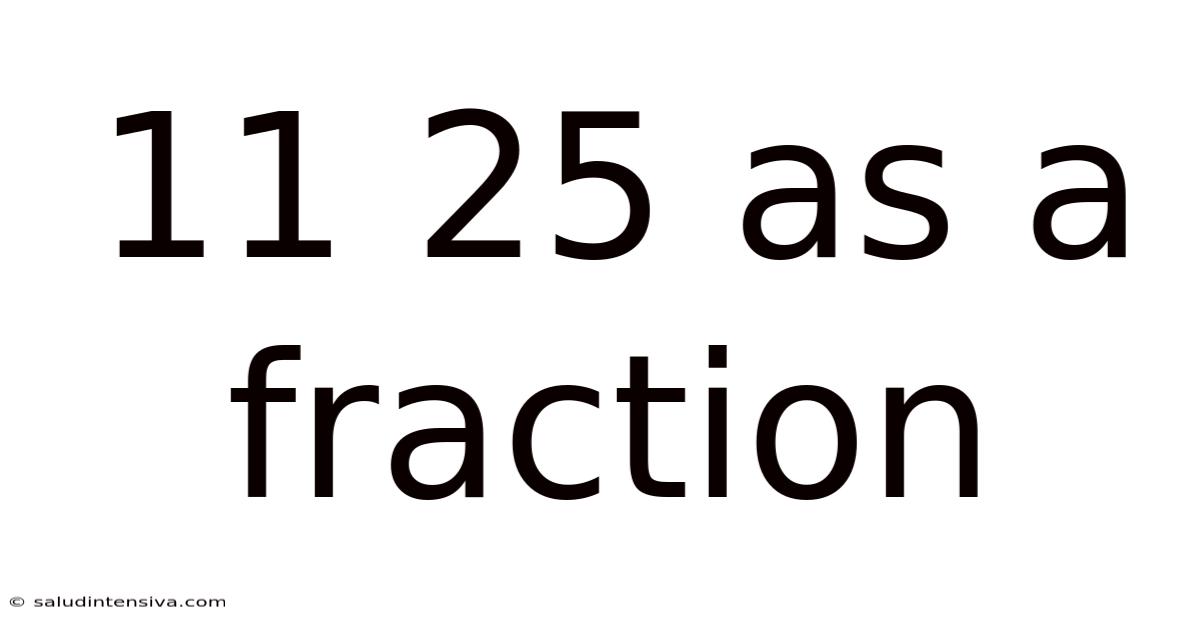11 25 As A Fraction
saludintensiva
Sep 23, 2025 · 4 min read

Table of Contents
Understanding 11:25 as a Fraction: A Comprehensive Guide
The seemingly simple question, "What is 11:25 as a fraction?", unveils a deeper understanding of time, ratios, and fraction simplification. This comprehensive guide will not only answer this question but also explore the underlying concepts, providing you with the tools to convert any time to a fraction and vice-versa. We'll delve into the practical applications, address common misconceptions, and even explore some advanced considerations. This will equip you with a robust understanding far beyond a simple numerical answer.
Understanding Time as a Ratio
Before diving into the conversion, let's establish a foundational understanding. Time, in this context, is represented as a ratio. The notation 11:25 signifies 11 hours and 25 minutes. To express this as a fraction, we need a common unit of measurement. Since there are 60 minutes in an hour, we'll convert everything to minutes.
Converting 11:25 to Minutes
First, we convert the hours into minutes: 11 hours * 60 minutes/hour = 660 minutes. Then, we add the existing 25 minutes: 660 minutes + 25 minutes = 685 minutes.
Expressing the Time as a Fraction of a Day
A day contains 24 hours, which equates to 24 hours * 60 minutes/hour = 1440 minutes. Therefore, 11:25 represents 685 minutes out of a total of 1440 minutes in a day. This gives us our initial fraction:
685/1440
Simplifying the Fraction
This fraction, while accurate, can be simplified. To simplify, we need to find the greatest common divisor (GCD) of 685 and 1440. Finding the GCD can be done using various methods, including the Euclidean algorithm. For this example, let's break it down:
- Factors of 685: 1, 5, 137, 685
- Factors of 1440: 1, 2, 3, 4, 5, 6, 8, 10, 12, 15, 16, 18, 20, 24, 30, 32, 36, 40, 45, 48, 60, 72, 80, 90, 96, 120, 144, 160, 180, 240, 288, 360, 480, 720, 1440
As we can see, the greatest common divisor of 685 and 1440 is 5.
Therefore, we can simplify the fraction by dividing both the numerator and the denominator by 5:
685 ÷ 5 = 137 1440 ÷ 5 = 288
This simplifies our fraction to:
137/288
This is the simplest form of the fraction representing 11:25.
Practical Applications
Understanding how to convert time to fractions has practical applications in various fields:
- Scheduling and Project Management: Precisely allocating time for tasks within a project requires accurate fractional representation of time.
- Data Analysis: When analyzing time-series data, representing time as fractions allows for more consistent and accurate calculations.
- Scientific Research: Experiments involving timed processes often require accurate fractional representation of time intervals.
- Payroll Calculations: Calculating overtime pay often involves precise calculations using fractions of an hour.
Addressing Common Misconceptions
A common mistake is to assume that 11:25 is simply 11/25. This is incorrect. Remember, the colon (:) signifies a ratio within a specific time system (hours and minutes), not a simple numerical ratio.
Another common error is failing to simplify the fraction to its lowest terms. While 685/1440 is technically correct, 137/288 is the more useful and concise representation.
Advanced Considerations: Different Time Units
The above example focused on hours and minutes within a 24-hour day. The principles remain the same when dealing with other time units:
- Seconds: If you need to incorporate seconds, you would convert everything to seconds (there are 86,400 seconds in a day).
- Other Time Systems: While less common, the approach remains the same for time systems with different base units (e.g., different numbers of minutes in an hour).
Frequently Asked Questions (FAQ)
Q: Can I convert this fraction back to time?
A: Absolutely! To convert 137/288 back to time, multiply the fraction by 1440 minutes (the number of minutes in a day):
(137/288) * 1440 = 685 minutes
Then, divide by 60 to get the number of hours and minutes:
685 ÷ 60 ≈ 11 hours and 25 minutes.
Q: What if I have a time that includes seconds?
A: You would convert everything to seconds first, using the total number of seconds in a day (86,400 seconds) as your denominator.
Q: Why is simplifying the fraction important?
A: Simplifying the fraction makes it easier to understand, compare, and use in calculations. It provides a more concise and manageable representation of the time.
Q: Are there online calculators to help with this conversion?
A: While there aren't specific calculators dedicated solely to this conversion, general fraction calculators and time converters can be helpful. However, understanding the underlying process is crucial for broader applications.
Conclusion
Converting 11:25 to a fraction involves understanding time as a ratio, converting units, finding the greatest common divisor to simplify the fraction, and appreciating the significance of the resulting simplified fraction (137/288). This process extends beyond a simple numerical answer, offering valuable insights into the manipulation of time and ratios, with practical applications in various fields. Remember to always strive for the simplest form of the fraction for clarity and ease of use. By understanding the underlying principles, you can confidently tackle similar time conversions and confidently apply this knowledge to more complex problems.
Latest Posts
Latest Posts
-
90 Days From August 31
Sep 23, 2025
-
Convert 27 Inches To Centimeters
Sep 23, 2025
-
Lactate Threshold Calculator Heart Rate
Sep 23, 2025
-
Thermometer Degrees Fahrenheit And Celsius
Sep 23, 2025
-
26 Miles Converted To Kilometers
Sep 23, 2025
Related Post
Thank you for visiting our website which covers about 11 25 As A Fraction . We hope the information provided has been useful to you. Feel free to contact us if you have any questions or need further assistance. See you next time and don't miss to bookmark.